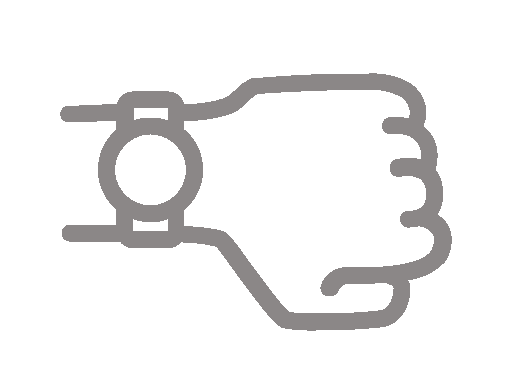


Research Question:
How do heart rate values differ when comparing popular wearable devices of the Apple Watch, Whoop, and Polar during a 10-minute walk?
With the increase in popularity of wearable devices over the past few years, it sparked my interest to create a self-motivated research study to compare a few of the leading brands. I felt that it was important to use these well-known brands as they target a multitude of different prospects. For instance, the Apple Watch is targeted at people who wear a watch daily but also want to track their fitness insights. The Whoop device was initially targeted toward elite athletes but has grown in popularity amongst the average population. The Polar H10 chest strap is typically seen amongst avid triathlon competitors, at least that's where it appeared on my radar. Overall, each of these wearable devices is easily accessible to the public, hence why a college student like myself could acquire and utilize each device for this study.
Now, it is important to note that throughout this study, the Apple Watch Series 3 was worn on my left wrist, the Polar H10 was worn on my chest, and the Whoop was worn on the lateral portion of my right bicep toward the shoulder. The different locations of each device were done purposefully so that not only could I compare the heart rate data, but do so in regard to various locations on the body. The goal here was that comparing different locations for each monitor may give insight into which location tracks heart rate most accurately.
This study took place over the course of 3 months where I participated in a 10-minute walk each day. There were times when the walk was completed on a treadmill set at my average walking pace of 3.3 miles per hour. This number was determined by averaging my typical walking pace when performing the experiment outside. I should also mention that I had trouble with the Polar H10 at the beginning of the study wherein it would start to track my data and cease to continue after a matter of minutes. However, this problem was resolved through a reset of the device and multiple strap adjustments. Overall, I had a really fun time throughout this study and it allowed me to combine my love for research and fitness into something enjoyable throughout my summer.
The figure to the right (below on mobile) shows the average heart rate of each device throughout this three-month study. From these results, you can see that, on average, each device tracked a similar average heart rate. However, the Whoop device followed a trend to underestimate the beats per minute compared to the Polar and Apple Watch devices. While this trend can be seen in the figure, the three devices did not surpass a difference in plus or minus 5 from the average. From this, when comparing all three devices, I can conclude that each device accurately calculated my average heart rate throughout the entire 10-minute walk but there could be room for improvement.
The figure to the left (above on mobile) shows the max heart rate values calculated by each device throughout the 10-minute bout of exercise. As you can see, there is a clear difference between the values calculated for max heart rate versus the values calculated for the average heart rate, in terms of their similarity between devices. It is evident that these metrics are extremely close, some of which are identical to one another. Seemingly, these companies have nearly perfected estimating max heart rate values in their wearable devices.
The figure to the right (below on mobile) shows the min heart rate comparison of each device throughout the study. It is clear that these metrics showcase the differences between the devices and the data they produce. Something of importance when comparing the devices and their applications is that Polar and Apple provide min heart rate values directly on the app results screen whereas Whoop requires the user to manually seek this value in their application. Perhaps including this data metric could be useful in their post-exercise report. Nonetheless, the most deviation between the heart rate data of all three devices came from the min heart rate comparison.
The figure to the left (above on mobile) showcases the estimated total calorie expenditure throughout the 10-minute bout of exercise. While I was not trying to answer the difference in caloric expenditure estimation among these devices, this piece of information is an added bonus that these devices track for their users. However, clearly, not a single device agreed with one another on the number of calories expended. This leads me to assume that none of the devices track caloric expenditure similarly and perhaps this metric is extremely difficult to calculate for any wearable. I believe that further research must be completed in order to solidify the differences in caloric expenditure among wearable technology.
The figure to the right (below on mobile) shows the average speed comparison of each of the three devices throughout the walking exercise. As you can see, there are many outliers indicating that, on occasion, the device did not track any speed relative to my actual miles per hour. The Apple Watch however never failed to track speed using the speedometer and my arm swing. It is likely that since the Polar was on my chest, and the Whoop on my upper arm, they were unable to accurately track speed, especially indoors while walking on a treadmill. I think this is a flaw in their design because of its inconsistency but as you can see, when speed was accurately calculated, each device produced comparable results.
Final Thoughts
It is clear that each of these devices has a positive and negative side to them when monitoring heart rate data metrics during a bout of exercise. The Apple Watch seemed to be the most consistent across the board, despite its min heart rate variation from the norm, but then again there wasn't exactly a norm to follow for that metric. The Whoop oftentimes failed at tracking speed throughout the walk and requires the user to seek out the min heart rate of a specific exercise. The Polar device, initially struggling to cooperate, had many errors regarding speed tracking but I believe that is due to the lack of GPS change while walking indoors.
Overall, the average heart rate across the three devices was relatively similar, only varying sometimes by less than 5 beats per minute and oftentimes varying by 1 or 2 beats per minute from the average. The max heart rate difference from the average at one point reached >10 bpm but that was during a time in which the Polar monitor ceased to track. For the most part, max heart rate differences between devices were <5 bpm. The min heart rate differences oftentimes varied >10 bpm from the average which is clear that this metric must be the hardest to track regularly amongst these devices.
There must be a better way for wearables to track min heart rate, caloric expenditure, and speed so that a standard is set for people to rely on the information that they are given. Since the difference in these data metrics varies so much compared to average and max heart rate values, it is safe to assume that these are areas where wearable tech lacks consistency amongst one another and should improve.
Throughout this study, my goal was to have fun while conducting my first research project. I believe that I have accomplished this goal as I found the process immensely satisfying. I want to thank my family and friends who pushed me to continue working towards my goal by (literally) walking alongside me every step of the way.
Get a free WHOOP 4.0 and one month free when you join with my link: https://join.whoop.com/A1863B




